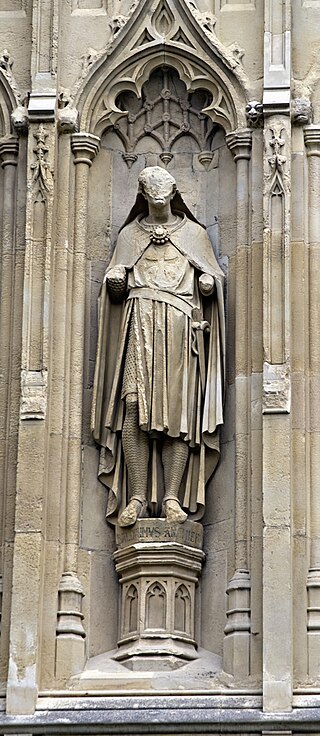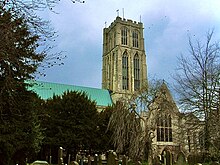
Richard I was King of England from 1189 until his death in 1199. He also ruled as Duke of Normandy, Aquitaine and Gascony; Lord of Cyprus; Count of Poitiers, Anjou, Maine, and Nantes; and was overlord of Brittany at various times during the same period. He was the third of five sons of Henry II of England and Eleanor of Aquitaine and seemed unlikely to become king, but his two elder brothers predeceased their father. Richard is known as Richard Cœur de Lion or Richard the Lionheart because of his reputation as a great military leader and warrior. The troubadour Bertran de Born also called him Richard Oc-e-Non, possibly from a reputation for terseness.
Thomas Walsingham was an English chronicler, and is the source of much of the knowledge of the reigns of Richard II, Henry IV, Henry V and the latter reign of Edward III depicting the decline of the state of affairs of the English. He also documented the careers of John Wycliff and Wat Tyler.
Benedict, sometimes known as Benedictus Abbas, was abbot of Peterborough. His name was formerly erroneously associated with the Gesta Henrici Regis Secundi and Gesta Regis Ricardi, English 12th century chronicles, which are now attributed to Roger of Howden.
Geoffrey was an illegitimate son of King Henry II of England who became bishop-elect of Lincoln and archbishop of York. The identity of his mother is uncertain, but she may have been named Ykenai. Geoffrey held several minor clerical offices before becoming Bishop of Lincoln in 1173, though he was not ordained as a priest until 1189. In 1173–1174, he led a campaign in northern England to help put down a rebellion by his legitimate half-brothers; this campaign led to the capture of William, King of Scots. By 1182, Pope Lucius III had ordered that Geoffrey either resign Lincoln or be consecrated as bishop; he chose to resign and became chancellor instead. He was the only one of Henry II's sons present at the king's death.

William de Longchamp was a medieval Lord Chancellor, Chief Justiciar, and Bishop of Ely in England. Born to a humble family in Normandy, he owed his advancement to royal favour. Although contemporary writers accused Longchamp's father of being the son of a peasant, he held land as a knight. Longchamp first served Henry II's illegitimate son Geoffrey, but quickly transferred to the service of Richard I, Henry's heir. When Richard became king in 1189, Longchamp paid £3,000 for the office of Chancellor, and was soon named to the see, or bishopric, of Ely and appointed legate by the pope.

Walter de Coutances was a medieval Anglo-Norman bishop of Lincoln and archbishop of Rouen. He began his royal service in the government of Henry II, serving as a vice-chancellor. He also accumulated a number of ecclesiastical offices, becoming successively canon of Rouen Cathedral, treasurer of Rouen, and archdeacon of Oxford. King Henry sent him on a number of diplomatic missions and finally rewarded him with the bishopric of Lincoln in 1183. He did not remain there long, for he was translated to Rouen in late 1184.

Ralph de Diceto was archdeacon of Middlesex, dean of St Paul's Cathedral, and author of two chronicles, the Abbreviationes chronicorum and the Ymagines historiarum.
Hugh de Puiset was a medieval Bishop of Durham and Chief Justiciar of England under King Richard I. He was the nephew of King Stephen of England and Henry of Blois, who both assisted Hugh's ecclesiastical career. He held the office of treasurer of York for a number of years, which led him into conflict with Henry Murdac, Archbishop of York. In 1153, Hugh was elected bishop of Durham despite the opposition of Murdac.

Donnchadh was a Gall-Gaidhil prince and Scottish magnate in what is now south-western Scotland, whose career stretched from the last quarter of the 12th century until his death in 1250. His father, Gille-Brighde of Galloway, and his uncle, Uhtred of Galloway, were the two rival sons of Fergus, Prince or Lord of Galloway. As a result of Gille-Brighde's conflict with Uhtred and the Scottish monarch William the Lion, Donnchadh became a hostage of King Henry II of England. He probably remained in England for almost a decade before returning north on the death of his father. Although denied succession to all the lands of Galloway, he was granted lordship over Carrick in the north.

Baldwin of Forde or Ford was Archbishop of Canterbury between 1185 and 1190. The son of a clergyman, he studied canon law and theology at Bologna and was tutor to Pope Eugene III's nephew before returning to England to serve successive bishops of Exeter. After becoming a Cistercian monk he was named abbot of his monastery at Forde and subsequently elected to the episcopate at Worcester. Before becoming a bishop, he wrote theological works and sermons, some of which have survived.
Folmar of Karden, also occurring in the variant forms Fulmar, Vollmar, Volcmar, Formal, or Formator, was the Archbishop of Trier from 1183 and the last not also to be a prince elector. He opposed the emperor in the late twelfth-century phase of the Investiture Controversy. The historian Bernhard von Simson characterized Folmar as "that restless, ambitious, and hard-hearted man."

Henry of Marcy, or Henri de Marsiac, was a Cistercian abbot, first of Hautecombe in Savoy (1160–1177), and then of Clairvaux, from 1177 until 1179. He was created Cardinal Bishop of Albano by Pope Alexander III at the Third Lateran Council in 1179.
The Battle of Mam Garvia, took place in 1187 in Northern Scotland. Domnall Meic Uilleim had resisted the King of Scots since at least 1179, he even had a claim to the throne as a grandson of King Donnchad II of Scotland. Lochlann, Lord of Galloway led an army north where according to Roger of Hoveden they defeated the Meic Uilleim, slew Domnall and cut off his head and carried it south to present it to King William. The actual site of the battle has been quoted as being either in Ross or near Moray, lately it has been reasoned to be in Strath Garve near Dingwall.

Roger de Lacy (1170–1211), Baron of Pontefract, Lord of Bowland, Lord of Blackburnshire, Baron of Halton, Constable of Chester, Sheriff of Yorkshire and Sheriff of Cumberland, also known as Roger le Constable, was a notable Anglo-Norman soldier, crusader and baron.
Burchard du Puiset was a medieval Anglo-Norman clergyman and treasurer of the diocese of York. Either the nephew or son of Hugh du Puiset, the Bishop of Durham, Burchard held a number of offices in the dioceses of York and Durham before being appointed treasurer by King Richard I of England in 1189. His appointment was opposed by the newly appointed Archbishop Geoffrey, which led to a long dispute between Geoffrey and Burchard that was not resolved until the mid 1190s. After the death of Hugh du Puiset, Burchard was a candidate for the Hugh's old bishopric, but lost out in the end to another candidate. Burchard died in 1196.
Captain Giles Hovenden or Hovendon was an Anglo-Irish Light Horseman who served in Ireland c. 1532. Hovenden had come to Ireland from the Parish of Ulcomb in Kent, England. He was head of the Hovenden family and for his military service received estates in Queen's County. He also developed business contacts with leading Irish figures such as Conn O'Neill. He exercised guardianship over Hugh O'Neill, the second son of the assassinated Matthew O'Neill, 1st Baron Dungannon. Hugh eventually rose to become the Earl of Tyrone, the most powerful Gaelic lord in Ireland, best remembered for leading Tyrone's Rebellion and the later Flight of the Earls. Tyrone remained close to the Hovendens, employing three of Giles' sons as officers in the forces that the Crown allowed him to maintain.

Jordan Lupin was the first count of Bovino in the Norman kingdom of Sicily. He played a major role in the final years of Norman rule and first years of the Staufer dynasty. Twice he was involved in opposing crusader armies passing through Sicily. In the second instance, he led a revolt, apparently in the hope of seizing the throne. He was successful in attracting significant support, and was even crowned anti-king, but was ultimately captured and executed.

Geoffrey of Lusignan was the Lord of Vouvant and Soubise, and Count of Jaffa and Ascalon. He was also Lord of Mervent and Moncontour by his wife's rights.
Raymond II was the 9th Viscount of Turenne from the House of Comborn. He was a son of Viscount Boson II and Eustorgie d'Anduze, and grandson of Raymond I of Turenne.










